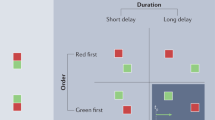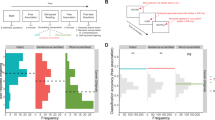Abstract
We conceive of time as a sequential order of real-world events, one event following another from past to present to future. This conception colours the way we speak of time (“we look forward to the time”) and, as we show here, the way we process written statements referring to the temporal order of events, in real time.Terms such as ‘before’ and ‘after’ give us the linguistic freedom to express a series of events (real or imaginary) in any order. However, sentences that present events out of chronological order require additional discourse-level computation. Here we examine how and when these computations are carried out by contrasting brain potentials across two sentence types that differonly in their initial word (‘After’ X, Y versus ‘Before’ X,Y). At sites on the left frontal scalp, the responses to ‘before’ and ‘after'sentences diverge within 300 ms; the size of this difference increases over the course of the sentences and is correlated with individual working-memory spans. Thus, we show that there areimmediate and lasting consequences for neural processing of the discourse implications of a single word on sentence comprehension.
This is a preview of subscription content, access via your institution
Access options
Subscribe to this journal
Receive 51 print issues and online access
$199.00 per year
only $3.90 per issue
Buy this article
- Purchase on Springer Link
- Instant access to full article PDF
Prices may be subject to local taxes which are calculated during checkout



Similar content being viewed by others
References
Carpenter, P. A., Miyake, A. & Just, M. A. Language comprehension: sentence and discourse processing. Annu. Rev. Psychol. 46, 91–120 (1995).
Graesser, A. C., Millis, K. K. & Zwaan, R. A. Discourse comprehension. Annu. Rev. Psychol. 48, 163–189 (1997).
McKoon, G. & Ratcliff, R. Memory-based language processing: psycholinguistic research in the 1990s. Annu. Rev. Psychol. 49, 25–42 (1998).
Turner, M. Reading Minds: The Study of English in the Age of Cognitive Science (Princeton Univ. Press, (1991)).
Langacker, R. W. Foundations of Cognitive Grammar (Stanford Univ. Press, (1987)).
Mecklinger, A., Schriefers, H., Steinhauer, K. & Friederici, A. D. Processing relative clauses varying on syntactic and semantic dimensions: an analysis with event-related potentials. Memory Cogn. 23, 477–494 (1995).
King, J. W. & Kutas, M. Who did what and when? Using word- and clause-level ERPs to monitor working memory usage in reading. J. Cogn. Neurosci. 7, 376–395 (1995).
Müller, H. M., King, J. W. & Kutas, M. Event-related potentials elicited by spoken relative clauses. Cogn. Brain Res. 5, 193–203 (1997).
Goldman-Rakic, P. S. The prefrontal landscape: implications of functional architecture for understanding human mentation and the central executive. Phil. Trans. R. Soc. Lond. B 351, 1445–1453 (1996).
Owen, A. M. The functional organization of working memory processes within human lateral frontal cortex: the contribution of functional neuroimaging. Eur. J. Neurosci. 9, 1329–1339 (1997).
Petrides, M. Specialized systems for the processing of mnemonic information within the primate frontal cortex. Phil. Trans. R. Soc. Lond. B 351, 1455–1461 (1996).
Just, M. A., Carpenter, P. A., Keller, T. A., Eddy, W. F. & Thulborn, K. R. Brain activation modulated by sentence comprehension. Science 274, 114–116 (1996).
Stromswold, K., Caplan, D., Alpert, N. & Rauch, S. Localization of syntactic comprehension by positron emission tomography. Brain Lang. 52, 452–473 (1996).
Macaruso, P., Bar-Shalom, E., Crain, S. & Shankweiler, D. Comprehension of temporal terms by good and poor readers. Lang. Speech 32, 45–67 (1989).
Natsopoulos, D. & Abadzi, H. Understanding linguistic time sequence and simultaneity: A literature review and some new data. J. Psycholing. Res. 15, 243–273 (1986).
Trosborg, A. Children's comprehension of “before” and “after” reinvestigated. J. Child Lang. 9, 381–402 (1982).
Natsopoulos, D., Mentenopoulos, G., Bostantzopoulou, S., Katsarou, Z., Grouios, G. & Logothetis, J. Understanding of relational time terms before and after in parkinsonian patients. Brain Lang. 40, 444–458 (1991).
Baayen, R. H., Piepenbrock, R. & van Rijn, H. The CELEX Lexical Database (CD-ROM).Linguistic Data Consortium, Univ. Pennsylvania(1993).
Daneman, M. & Carpenter, P. A. Individual differences in working memory and reading. J. Verb. Learn. Verb. Behav. 19, 450–466 (1980).
Perrin, F., Pernier, J., Bertrand, O., Giard, M. H. & Echallier, J. F. Mapping of scalp potentials by surface spline interpolation. Electroencephalogr. Clin. Neurophysiol. 66, 75–81 (1987).
McCarthy, G. & Wood, C. C. Scalp distributions of event-related potentials: an ambiguity associated with analysis of variance models. Electroencephalogr. Clin. Neurophysiol. 62, 203–208 (1985).
Acknowledgements
We thank K. Federmeier, R. Schul, B. Schmitt, J. King and R. Kluender for their comments. This research was supported by the NICHD, NIA, and the Hermann and Lilly Schilling Foundation, Essen, Germany.
Author information
Authors and Affiliations
Corresponding author
Rights and permissions
About this article
Cite this article
Münte, T., Schiltz, K. & Kutas, M. When temporal terms belie conceptual order. Nature 395, 71–73 (1998). https://doi.org/10.1038/25731
Received:
Accepted:
Issue Date:
DOI: https://doi.org/10.1038/25731
This article is cited by
-
Language production and working memory in classic galactosemia from a cognitive neuroscience perspective: future research directions
Journal of Inherited Metabolic Disease (2011)
-
Neurophysiological correlates of linearization in language production
BMC Neuroscience (2008)
-
Von den Schwierigkeiten mit dem klassischen Nachrichten-Aufbau — oder: Ein »Andock-Modell« als Alternative zum »Pyramiden-Modell«
Publizistik (1999)
Comments
By submitting a comment you agree to abide by our Terms and Community Guidelines. If you find something abusive or that does not comply with our terms or guidelines please flag it as inappropriate.



